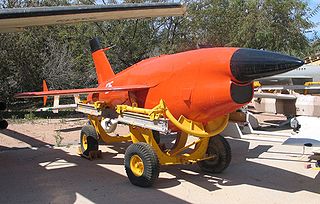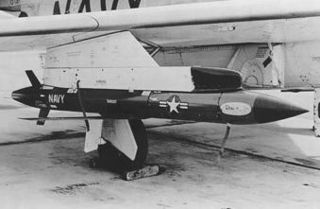
The BQM-74 Chukar is a series of aerial target drones produced by Northrop. The Chukar has gone through three major revisions, including the initial MQM-74A Chukar I, the MQM-74C Chukar II, and the BQM-74C Chukar III. They are recoverable, remote controlled, subsonic aerial target, capable of speeds up to Mach 0.86 and altitudes from 30 to 40,000 ft.

The AQM-35 was a supersonic target drone produced by the Northrop Corporation.

The AQM-38 was an American target drone, developed during the 1950s by the Radioplane Division of the Northrop Corporation, Newbury Park, California, and manufactured by its Ventura Division at Van Nuys, California. Extensively used for surface-to-air missile training, over two thousand were built during its production run and it saw continued use within the United States Army and United States Navy for nearly twenty years.

The Ryan Firebee is a series of target drones developed by the Ryan Aeronautical Company beginning in 1951. It was one of the first jet-propelled drones, and remains one of the most widely used target drones ever built.

The AQM-60 Kingfisher, originally designated XQ-5, was a target drone version of the USAF's X-7 ramjet test aircraft built by the Lockheed Corporation. The aircraft was designed by Kelly Johnson, the designer who later created the Lockheed A-12 and its relatives, such as the Lockheed SR-71 Blackbird and Lockheed YF-12.

The Leduc 022 was the prototype of a mixed-power French interceptor built in the mid-1950s. Designer René Leduc had been developing ramjet-powered aircraft since before World War II and had flown a series of experimental aircraft, the Leduc 0.10 and Leduc 0.21, throughout the Fifties before he was awarded a contract for two examples of a short-range supersonic interceptor armed with two air-to-air missiles (AAMs).

The MA-31 was a conversion of the Kh-31 anti-ship missile, developed by the Soviet Union during the 1980s, for use as a target drone by the United States Navy. Although the missile proved successful in this role, political complications resulted in the type being only an interim solution, and only a small number of the missiles were acquired.

The AQM-127 Supersonic Low-Altitude Target (SLAT) was a target drone developed during the 1980s by Martin Marietta for use by the United States Navy. Derived from Martin Marietta's work on the cancelled ASALM missile, SLAT proved to have severe difficulties in flight testing, and the project was cancelled during 1991.

The XBQM-108A was an experimental VTOL unmanned aerial vehicle developed by the United States Navy during the 1970s. Although the XBQM-108A successfully conducted tethered flight tests, the project was cancelled before any free flights could be conducted.

The Creative Research On Weapons or Crow program was an experimental missile project developed by the United States Navy's Naval Air Missile Test Center during the late 1950s. Intended to evaluate the solid-fueled integral rocket/ramjet (SFIRR) method of propulsion as well as solid-fueled ramjet engines, flight tests were conducted during the early 1960s with mixed success.
The ASM-N-5 Gorgon V was an unpowered air-to-surface missile, developed by the Glenn L. Martin Company during the early 1950s for use by the United States Navy as a chemical weapon delivery vehicle. Developed from the earlier PTV-N-2 Gorgon IV test vehicle, the program was cancelled without any Gorgon Vs seeing service.

The Temco XKDT Teal was an American rocket-propelled, high-performance target drone, built by Temco Aircraft for evaluation by the United States Navy in the late 1950s. Production was not proceeded with following evaluation of the type.

The Globe KD6G Firefly is an American target drone, built by the Globe Aircraft Corporation for operation by the United States Navy during the 1950s and early 1960s.

The Radioplane XKD4R, known by the company designation RP-70, was an American target drone developed by the Radioplane Division of the Northrop Corporation. Although it was not produced in quantity, it was developed into the successful AQM-38.
The Nord CT.41 Narwhal was a French target drone, designed and built by Nord Aviation during the late 1950s for the purpose of providing training in the interception of supersonic bomber aircraft.

The PTV-N-2 Gorgon IV was a subsonic ramjet-powered missile developed by the Glenn L. Martin Company for the United States Navy. Originally intended as an air-to-surface weapon, it materialized as a propulsion test vehicle, and between 1947 and 1950 was used for test purposes and, as the KDM Plover, as a target drone.

The Republic SD-3 Snooper was an early reconnaissance drone developed by Republic Aviation for the United States Army. It was evaluated by the Army Signal Corps in 1959, but did not enter operational service.
The Republic SD-4 Swallow was an early high-speed reconnaissance drone developed by Republic Aviation for the United States Army. Intended for use by the U.S. Army Signal Corps to target tactical ballistic missiles, it was cancelled before the first prototype could be completed, and did not see operational service.

The Fairchild SD-5 Osprey was an early high-speed reconnaissance drone developed by Fairchild Aircraft for the United States Army. Intended for use by the U.S. Army Signal Corps to target tactical ballistic missiles, it was cancelled before the first prototype could be completed, and did not see operational service.
The Marquardt MA-74 was a ramjet engine built by the Marquardt Corporation for use in supersonic target drones in the 1960s.
















